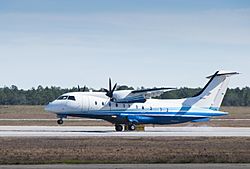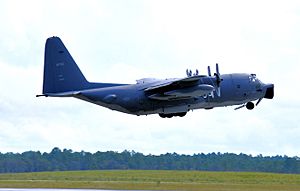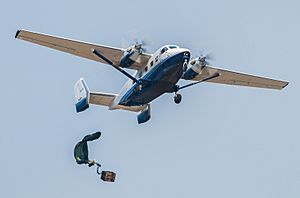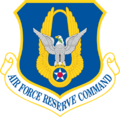Duke Field facts for kids
Quick facts for kids Duke Field |
|||||||||
|---|---|---|---|---|---|---|---|---|---|
| Eglin Air Force Auxiliary Field #3 | |||||||||
| Part of Eglin Air Force Base | |||||||||
| Near Crestview, Florida in United States of America | |||||||||

A Dornier C-146A Wolfhound of the 919th Special Operations Wing based at Duke Field.
|
|||||||||
 |
|||||||||
|
Duke Field
|
|||||||||
| Coordinates | 30°39′01″N 086°31′22″W / 30.65028°N 86.52278°W | ||||||||
| Type | US Air Force base | ||||||||
| Site information | |||||||||
| Owner | Department of Defense | ||||||||
| Operator | US Air Force | ||||||||
| Controlled by | Air Force Reserve Command (AFRC) | ||||||||
| Condition | Operational | ||||||||
| Site history | |||||||||
| Built | 1941 – 1942 | ||||||||
| In use | 1942 – present | ||||||||
| Garrison information | |||||||||
| Garrison | 919th Special Operations Wing | ||||||||
| Airfield information | |||||||||
| Identifiers | IATA: EGI, ICAO: KEGI, FAA LID: EGI, WMO: 722246 | ||||||||
| Elevation | 59.4 metres (195 ft) AMSL | ||||||||
|
|||||||||
| Other airfield facilities |
2x VTOL pads and 1x Landing Helicopter Deck | ||||||||
Duke Field (IATA: EGI, ICAO: KEGI, FAA LID: EGI), also known as Eglin AFB Auxiliary Field #3, is a special military airport. It is located about 3 miles (5 km) south of Crestview, in Okaloosa County, Florida, in the United States of America. It is a key part of the larger Eglin Air Force Base complex.
Contents
The Story of Duke Field
Duke Field was one of the first extra airfields built for the Eglin Field complex. Work started in January 1941, and the first buildings were ready by February 1942.
Early Days and World War II
In 1942, Duke Field was a training base for the famous Doolittle Raiders. These brave pilots practiced taking off from short runways, which helped them prepare for a secret mission during World War II. After the war, the field was even used to film parts of the movie Twelve O'Clock High.
Cold War Missions
In the 1950s, Duke Field became home to the 3205th Drone Group. This group flew special remote-controlled planes like the B-17 and F-80. These planes were used for target practice and to gather information by flying through atomic test clouds.
A large steel hangar, called the "Butler Hangar," was moved to Duke Field around 1950. It was made bigger to fit large planes like the B-17s. The main runway was also widened and new parking areas were built.
In the early 1960s, Duke Field played a secret role in preparing for the Bay of Pigs Invasion. Planes like the Douglas C-54 and C-46 were used to move people and supplies. About 20 B-26 planes were also prepared for use by Cuban pilots.
Special Operations and Modern Use
From August to October 1970, during the Vietnam War, Duke Field helped train US Army Special Forces. These troops were preparing for Operation Ivory Coast, a mission to rescue prisoners in North Vietnam.
On July 30, 1971, the 919th Tactical Airlift Group (919 TAG) was formed at Duke Field. They flew C-130A Hercules aircraft. This group became the main unit at Duke Field.
In 1975, the 919 TAG changed its mission to special operations and became the 919th Special Operations Group (919 SOG). They became the only Air Force Reserve unit to fly the AC-130 Spectre gunship.
In 1980, Duke Field was also used for training for Operation Credible Sport. This was a plan to rescue American hostages in Iran. Special C-130 planes were modified to land and take off in very short distances.

In 1992, the 919 SOG became the 919th Special Operations Wing (919 SOW), which is its name today. In 1995, their old AC-130A planes were retired. The 919 SOW then started flying MC-130E Combat Talon I and MC-130P Combat Shadow aircraft. These planes are used for special missions all over the world.
Since 1997, the 919 SOW has been part of the Air Force Reserve Command (AFRC). They work closely with the Air Force Special Operations Command (AFSOC), which is based nearby.
In 2000, about 170 active duty Air Force maintenance workers joined the 919 SOW at Duke Field. They worked together with the Air Force Reserve members to keep the MC-130E planes in good shape. This was a special partnership at the time.
Doolittle Reunion
On May 31, 2008, six of the original Doolittle Raiders came to Duke Field for their annual reunion. Civilian B-25 planes, like the ones used in the raid, performed a special take-off show.
What Duke Field Does Today
Even though it's part of Eglin Air Force Base, Duke Field acts like its own small air force base. It is mainly home to the 919th Special Operations Wing (919 SOW).
The 919 SOW currently flies several types of aircraft, including the MQ-9 Reaper, U-28A Draco, C-145A Skytruck, and C-146A Wolfhound. As an Air Force Reserve unit, the 919 SOW supports the Air Force Special Operations Command (AFSOC). The wing has 13 squadrons, with two of them located at Hurlburt Field, Florida.
Units Based at Duke Field
Here are some of the important flying and non-flying units that call Duke Field home. Some units are "Geographically Separate Units" (GSUs), meaning they are based at Duke but report to a parent unit elsewhere.
United States Air Force
- Air Force Reserve Command (AFRC)
- Tenth Air Force
- 919th Special Operations Wing (Host Unit)
- 919th Special Operations Group
- 919th Special Operations Wing (Host Unit)
- Tenth Air Force
* 311th Special Operations Intelligence Squadron * 711th Special Operations Squadron – Flies C-145A Skytruck planes * 859th Special Operations Squadron – Handles Non-Standard Aviation (NSAV) missions * 919th Special Operations Support Squadron
-
-
-
- 919th Special Operations Maintenance Group
-
-
* 919th Special Operations Maintenance Squadron * 919th Special Operations Aircraft Maintenance Squadron * 919th Maintenance Operations Flight
-
-
-
- 919th Special Operations Medical Squadron
- 919th Special Operations Mission Support Group
-
-
* 919th Special Operations Civil Engineer Squadron * 919th Special Operations Security Forces Squadron * 919th Special Operations Communications Squadron * 919th Special Operations Logistics Readiness Squadron * 919th Special Operations Force Support Squadron
- Air Force Special Operations Command (AFSOC)
- 492d Special Operations Wing
- 6th Special Operations Squadron (GSU) – Flies C-145A Skytruck planes
- 524th Special Operations Squadron (GSU) – Flies C-146A Wolfhound planes
- 492d Special Operations Wing
- Air Force Materiel Command (AFMC)
- Air Force Test Center
- 96th Operations Group
- 413th Flight Test Squadron (GSU) – Tests planes like the CV-22 Osprey, HH-60W Pave Hawk, UH-1N Iroquois
- Detachment 1 (GSU) – Tests planes like the AC-130J Ghostrider, C-130 Hercules, HC-130J Combat King II, MC-130J Commando II
- 96th Operations Group
- Air Force Test Center
- Air Force Global Strike Command (AFGSC)
- Detachment 7 – Flies MH-139A Grey Wolf helicopters
Facilities at Duke Field
Duke Field is named after 1st Lt Robert L. Duke. He was an Air Force officer who sadly died in a plane crash in 1943.
The Duke Field base is about 12 miles (19 km) north of the main Eglin Air Force Base.
Duke Field has two paved runways. The main runway is 8,025 feet (2,446 meters) long. There's also a shorter "Assault Runway" that is 3,500 feet (1,067 meters) long.
Even though it's called an "auxiliary field" (meaning an extra field) to Eglin AFB, Duke Field has everything a small air force base needs. It has its own air traffic control tower, security buildings, fire station, and systems to help planes land safely. It also has large areas for planes, hangars, a small shop, a gas station, a hotel, fitness areas, and other buildings for support.
Images for kids





